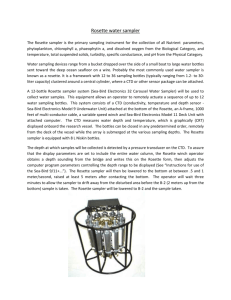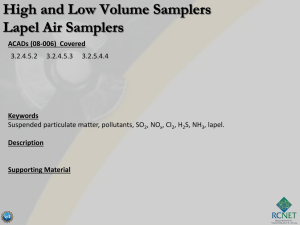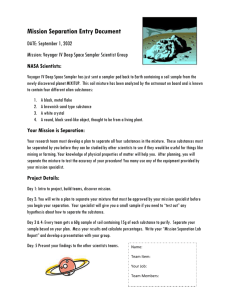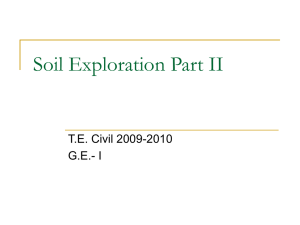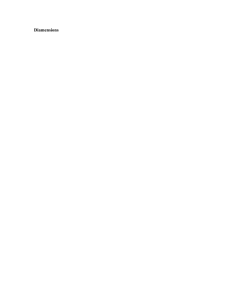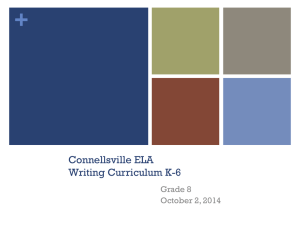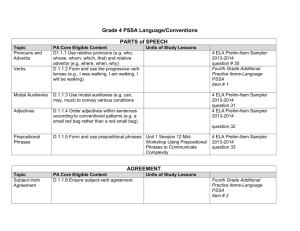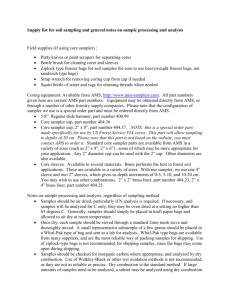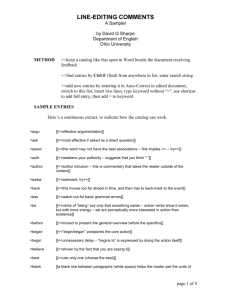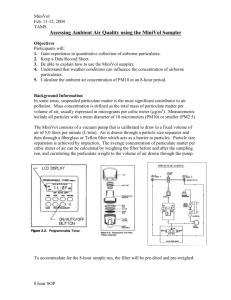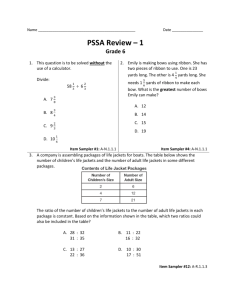Marine Survey Research and Explorations
advertisement
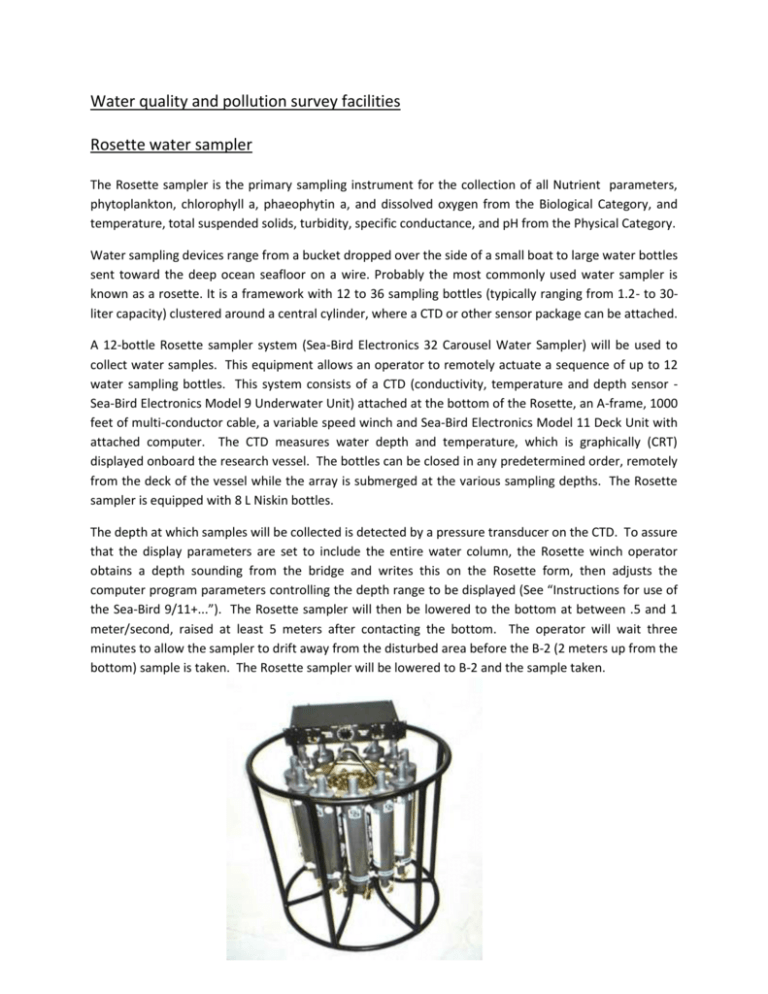
Water quality and pollution survey facilities Rosette water sampler The Rosette sampler is the primary sampling instrument for the collection of all Nutrient parameters, phytoplankton, chlorophyll a, phaeophytin a, and dissolved oxygen from the Biological Category, and temperature, total suspended solids, turbidity, specific conductance, and pH from the Physical Category. Water sampling devices range from a bucket dropped over the side of a small boat to large water bottles sent toward the deep ocean seafloor on a wire. Probably the most commonly used water sampler is known as a rosette. It is a framework with 12 to 36 sampling bottles (typically ranging from 1.2- to 30liter capacity) clustered around a central cylinder, where a CTD or other sensor package can be attached. A 12-bottle Rosette sampler system (Sea-Bird Electronics 32 Carousel Water Sampler) will be used to collect water samples. This equipment allows an operator to remotely actuate a sequence of up to 12 water sampling bottles. This system consists of a CTD (conductivity, temperature and depth sensor Sea-Bird Electronics Model 9 Underwater Unit) attached at the bottom of the Rosette, an A-frame, 1000 feet of multi-conductor cable, a variable speed winch and Sea-Bird Electronics Model 11 Deck Unit with attached computer. The CTD measures water depth and temperature, which is graphically (CRT) displayed onboard the research vessel. The bottles can be closed in any predetermined order, remotely from the deck of the vessel while the array is submerged at the various sampling depths. The Rosette sampler is equipped with 8 L Niskin bottles. The depth at which samples will be collected is detected by a pressure transducer on the CTD. To assure that the display parameters are set to include the entire water column, the Rosette winch operator obtains a depth sounding from the bridge and writes this on the Rosette form, then adjusts the computer program parameters controlling the depth range to be displayed (See “Instructions for use of the Sea-Bird 9/11+...”). The Rosette sampler will then be lowered to the bottom at between .5 and 1 meter/second, raised at least 5 meters after contacting the bottom. The operator will wait three minutes to allow the sampler to drift away from the disturbed area before the B-2 (2 meters up from the bottom) sample is taken. The Rosette sampler will be lowered to B-2 and the sample taken. Additional time intervals of three minutes are allowed to elapse prior to taking the thermocline sample and the lower epilimnion sample. These intervals provide time for water equilibration within the Niskins. The knees of the EBT temperature depth trace will be determined by trisecting the angle between the epilimnion and mesolimnion temperature traces (upper knee) and the angle between the mesolimnion and hypolimnion temperature traces (lower knee). The upper knee is the upper a angle intercept, the lower knee is the lower a angle intercept. The lower epilimnion sample is one meter above the upper knee. The upper hypolimnion sample is one meter below the lower knee. Nansen bottles A Nansen bottle is a device for obtaining samples of seawater at a specific depth. The bottle, more precisely a metal or plastic cylinder, is lowered on a cable into the ocean, and when it has reached the required depth, a brass weight called a "messenger" is dropped down the cable. When the weight reaches the bottle, the impact tips the bottle upside down and trips a spring-loaded valve at the end, trapping the water sample inside. The bottle and sample are then retrieved by hauling in the cable. A second messenger can be arranged to be released by the inverting mechanism, and slide down the cable until it reaches another Nansen bottle. By fixing a sequence of bottles and messengers at intervals along the cable, a series of samples at increasing depth can be taken. The sea temperature at the water sampling depth is recorded by means of a reversing thermometer fixed to the Nansen bottle. This is a mercury thermometer with a constriction in its capillary tube which, when the thermometer is inverted, causes the thread to break and trap the mercury, fixing the temperature reading. Since water pressure at depth will compress the thermometer walls and affect the indicated temperature, the thermometer is protected by a rigid enclosure. A nonprotected thermometer is paired with the protected one, and comparison of the two temperature readings allows both temperature and pressure at the sampling point to be determined. Ruttner sampler Ruttner water Sampler can be used for limnological and hydro- biological investigation. It is employed in the water column at various depths in order to obtain water for the analysis of nutrients and pollutants. Plankton is sampled with a tube in order to allow for sampling over the entire water depth and in different areas. Gab Sampler This sampler is designed to collect an accurate representative sample of the sediment bottom. The bite of the sampler should be deep enough so all depths are sampled equally. The closing mechanism is required to completely close and hold the sample as well as prevent wash-out during retrieval. Likewise, during descent the sampler should be designed to minimize disturbance of the topmost sediment by the pressure wave as it is lowered to the bottom. The proven design of the super heavyweight grab sampler facilitates its use in all types of bottom substrates, except hard-packed clays. A simple pin mechanism prevents accidental closure of the dredge while in transit. Plankton Net Plankton Nets are a modification on the standard trawl used to collect planktonicorganisms, of nearly any size, intact. Towed by a research vessel, Plankton Nets have a long funnel shape that allows them to catch differently sized plankton simply by changing the mesh size of the net. At the end of the funnel is a collection cylinder called a cod-end. Phytoplankton can be collected with a Ruttner sampler. Primary productivity, Nutrients and Pollution Primary productivity is a term used to describe the rate at which plants and other photosynthetic organisms produce organic compounds in an ecosystem. There are two aspects of primary productivity: Eutrophication is the “excess supply of nutrients leading to increased biological productivity” The nutrients found in seawater are essential to the survival of plant and marine life. Phosphate, Nitrate- Nitrogen, Nitrite- Nitrogen and Ammonical- Nitrogen are the main nutrients measured for analysis of sea water. Pollution in the ocean directly affects ocean organisms and indirectly affects human health and resources. Oil spills, toxic wastes, and dumping of other harmful materials are all major sources of pollution in the ocean. Samples of seawater for determining the above factors can be obtained with Ruttner sampler, Nansen bottles and rosette sampler. Bottom grab sampler can be used for collecting of sediments. Wet lab Auto Sal Ultra Violet – Vis Spectro photometer Dry Lab Echo Sounders, multi beam echo sounder , single beam echo sounder, ADCP , sub bottom profiler , side scan sonar CTD , rosette Hydrographic Survey Facilities The research Vessel RV/ Samudrika equipped with Acoustic Doppler Current Profiler (ADCP) and Conductivity Temperature Depth (CTD) profiler to measure physical oceanographic parameters such as current velocity, temperature and conductivity of water column. Those instruments are advance technologies which can be utilised in oceanographic applications. Bathymetry Single Beam Echo Sounder Transponder transducer frequency (why) 4000 m, with DGPS Echo sounder Display picture Hypack data acquisition system Results (picture) Atlas Multi beam Ecosounder Three dimensional Swath angle (150 degree) Maximum depth 300 m Model Reson Seabat 8101 Results (picture) Instrument and display (picture) Dry Lab On board data processing facilities Three phase Communication Immarset –
